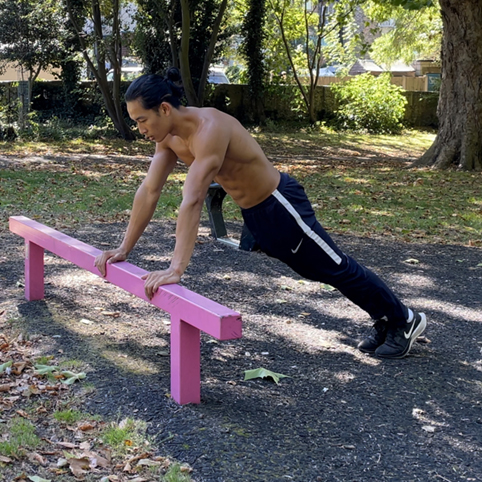
Gymless.org trainer, Pat Chadwick demonstrates a modified pushup
By Pat Chadwick
How many pushups can you do in a row?
If your answer is “fewer than 10,” don’t feel too bad. According to a recent national poll, you’re in good company. The poll revealed that 53.8% of Americans could not perform ten consecutive pushups. Over one-third can’t complete even five.
The poll, published by Gymless.org, a free educational resource specializing in at-home bodyweight fitness, included a national sample of 2,000 American adults, 18 to 65-plus.
While the results may be alarming to some, the good news is that anyone can improve their pushup skills regardless of their age, location, income, or fitness status.
As a calisthenics trainer, I’ve helped clients of all ages get in the shape of their lives without the need for a gym membership or fancy equipment.
Follow me as I break down the results of our recent pushup survey, explain their importance, and share a few tips for improving your upper body strength with pushups.
The Bright Side
For the most part, age is a non-factor for pushup ability. Survey responses were fairly evenly distributed across all age groups, from 18 to seniors aged 65 and up.
Surprisingly, a higher percentage of respondents between the ages of 25 and 34 said they couldn’t do five pushups than respondents aged 45 to 54. Among those aged 65 and older, only 8.29% claimed to be unable to surpass the five pushup mark.
In short, don’t let age get in the way of making progress on your pushups. Age isn’t as large of a factor as you might assume—instead, it’s more a matter of having the will to exercise and lead a healthy lifestyle.
Why Pushups?
Pushups are the king of upper body strength exercises. They recruit several key muscle groups that we use in our day-to-day lives, such as:
- Pectoralis major
- Pectoralis minor
- Deltoids
- Latissimus dorsi
- Triceps
Pushups also rank among the most accessible fitness movements. You can do them anywhere and anytime, without weights or equipment. For this reason, I always recommend my clients incorporate pushups into their fitness routine. But it’s not just me who thinks this way; our nation’s public health experts also take my side on this one.
What the Experts Have to Say About Pushups
A 2019 research study by Dr. Justin Yang and colleagues, published in JAMA Network, a leading peer-reviewed scientific journal, found a negative correlation between pushup capacity and one’s risk of cardiovascular disease.
In simpler terms, the fewer pushups you can do, the more at risk you are for heart disease. Over a 10-year period, Dr. Yang found that adults who could perform 40 pushups were a whopping 96% less likely than the average American to develop heart health complications.
The pushup is such a fundamental movement that the American College of Sports Medicine (ACSM) has even set national benchmarks for pushup repetitions. For adults over the age of 50, the ACSM recommends the following:
- Men (50-59): Between 10 and 12 pushups
- Men (60+): Between 8 and 10 pushups
- Women (50-59): Between 7 and 10 pushups
- Women (60+): Between 5 and 11 pushups
- Note that the ACSM allows women to perform “knee pushups” over regular pushups if they prefer. Knee pushups are a modified version of pushups explained in detail below.
How to Improve Your Pushup Capacity
You can make incredible progress on your pushup skills with a little consistency and creativity no matter your fitness level.
My advice is to start small and modify the movement to lower the weight resistance and the strain on your elbow joints. As with all strength movements, gradually increase the intensity with time as you progress. Here are some examples of modified pushups:
- Diamond pushups (Difficult): In a plank position, place your hands close together so that your index fingers and thumbs make a “diamond” formation. This version recruits more of your triceps than pectoralis and is meant for those who are more advanced.
- Knee pushups (Easier): In a plank position, lower your knees to the ground. Perform regular pushups with your knees grounded and acting as a fulcrum for your bodyweight. This makes the movement easier to perform by lowering the resistance.
- Couch pushups (Easier): Lay in a plank position with your feet on the floor and your hands planted on your couch or coffee table. Perform pushups as usual, with your hands stationed on an elevated surface to reduce overall load.
- Wall pushups (Easiest): Face a wall while standing upright and, with both hands firmly planted on the wall at shoulder-width, lower yourself forward until your face nearly touches the wall. Push away until your arms are fully extended, then repeat.
For each exercise, perform 2 to 10 repetitions in a row before resting between 60 and 90 seconds. Then, repeat for another set of as many repetitions. In total, perform three sets with an ample rest period.
My recommendation is to incorporate pushups (whether modified or not) into your workouts up to twice per week if you want to see improvement in this skill. As the workouts become easier, gradually ratchet up the intensity by increasing the number of repetitions or changing your choice of movement modification.
Other Tips for Taking Your Fitness Level
No matter your age, improving your pushup capacity is not only possible but hugely beneficial for your overall health and quality of life.
The ability to push and control one’s own body weight is a fundamental fitness skill that has a variety of real-life uses. For example, operating a lawnmower, shoveling snow or dirt, opening heavy doors, and basic self-defense all implicate the same muscle groups as pushups.
However, pushups are merely one component of a healthy, holistic fitness regimen. Other essential bodyweight movements include the following:
-
- Air squats (knees at a 90-degree angle or below)
- Walking lunges
- Overhead press (can be performed with weights, water bottles, or any household object that allows you to get a firm grip)
- Plank holds
- Sit-ups
Performing these movements in addition to pushups and low-impact cardio—such as walking, jogging, swimming, or cycling—will take your fitness to new heights, no matter your age.
With a nutritious diet and enough consistency, you will be able to perform 10 pushups or more before long. At which point, you’ll be able to say that you can do more pushups than the average American!











